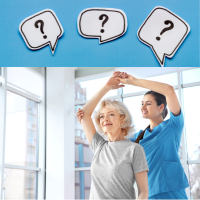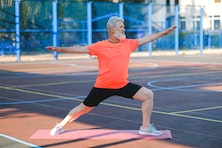Hemiplegia and Hemiparesis
Medically reviewed by Karen Murray, OTR, CHT, CSRS - written by Stroke-rehab.com
Hemiplegia is paralysis of one side of the body. Hemiparesis is weakness of one side of the body and is less severe than hemiplegia. Both are a common side effect of stroke or cerebrovascular accident.
One may wonder how only one side of the body can become paralyzed or weak after a stroke. One sided paralysis or weakness occurs when a stroke affects the corticospinal tract of one side of the brain. The right side of the brain controls the motor function of the left side of the body. The left side of the brain controls the motor function of the right side of the body. Thus when one side of the brain is damaged, it causes only one side of the body to be affected.
Techniques to Deal with Hemiplegia and Hemiparesis:
Range of Motion - Moving the paralyzed or weak limb or extremity can help prevent stiffness and muscle contractures. Range of motion can be passive, active-assistive, or active depending if the extremity or limb can voluntarily produce any movement or if it has to be moved by an external factor such as a caregiver. View passive range of motion exercises you can do yourself at www.stroke-rehab.com/passive-range-of-motion.html or view exercises the caregiver can do for the patient at www.stroke-rehab.com/stroke-rehab-exercises.html under the passive range of motion section.
Orthotics (Braces) - One may be prescribed a wrist and hand orthoses (WHO), elbow brace, or ankle foot orthoses (AFO) to help maintain proper joint alignment, provide support to weak muscles, and prevent contractures.
Slings - There are various arm slings that help support the arm when subluxation is a problem. Subluxation occurs when the head of the humerus (upper arm bone) has dropped out of the shoulder socket due to weakened ligaments and musculature.
Positioning - It is important to position the weak arm or leg appropriately. When sitting, one can support the affected arm on a pillow, lapboard, or tray. If using one of these devices, make sure that the height is appropriate and not pushing the shoulder up too high. The leg during sitting should be positioned comfortably without too much rotation at the hip. Try to position the knee where it is facing forward and not out to the side or turned inward. The foot should be flat on the floor or footrest with no rolling of the ankle.
When lying on your back, place a pillow by your side (parallel to your body) and place the weak arm out straight on the pillow. If there is edema in the hand, you can use an extra pillow to elevate the hand to decrease swelling. When lying on your non-affected side, support the weak arm and leg on pillows in front of the body. If lying on the weak side, just make sure the affected shoulder is slightly forward and that you are not lying directly on the shoulder joint.
Strengthening - Strengthening and active range of motion exercises can be done with stroke patients who have hemiparesis. Patients with more severe paralysis may have some small individual movements that can be strengthened as well. Electrical stimulation (e-stim) can also be used to help activate and strengthen weak muscles.
Compensatory Techniques - One may have to use compensatory techniques to overcome problems caused by hemiplegia. Adaptive equipment is available to make mobility and ADLs easier. Examples of adaptive equipment include hemi-walkers, bathroom transfer benches, raised toilets, dressing aids, and more. Adaptive clothing is also available to stroke patients to allow for easy fastening, removal, and even changing clothing entirely from a seated position.
Get Our Stroke Rehab Guide

Our stroke rehab guide is designed specifically for patients and caregivers. It's in pdf format and can be immediately downloaded. It includes about
- Stroke Definition & Causes
- Stroke Treatment
- Rehabilitation Information for Physical, Occupational and Speech Therapy
- Exercise pictures
- Q&A from patients and caregivers
- Adaptive Equipment & Techniques
- How to Prevent Another Stroke & More!
Medical Disclaimer: All information on this website is for informational purposes only. This website does not provide medical advice or treatment. Always seek the advice of your physician or other healthcare provider before undertaking a new healthcare or exercise regimen. Never disregard professional medical advice or delay seeking medical treatment because of something you have read on this website. See the disclaimer page for full information.
















